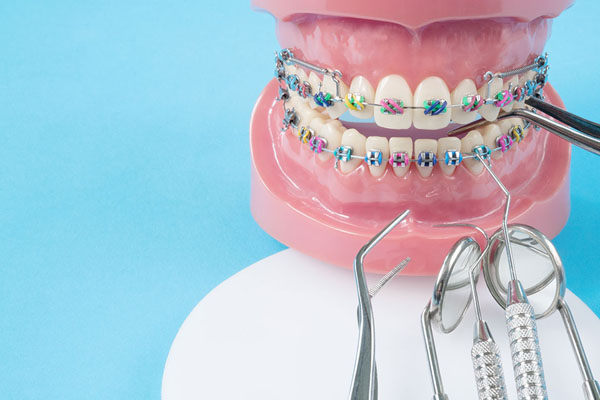Invisalign® vs Braces
Do You Need Traditional Braces or Invisalign Aligners?
If you’re considering orthodontic treatment to improve your smile, you may be wondering which option is right for you. Both Invisalign® and braces are effective ways to straighten teeth and correct bite issues, but each has unique advantages and disadvantages patients should consider.
To get started on a treatment plan for straightening teeth, contact our dentist in Bakersfield, CA, today. We’ll schedule your consultation to evaluate your oral health. Call us at 661-664-9900.

Invisalign: Process, Pros, and Cons
How Invisalign Works
Invisalign is a modern alternative to traditional braces, using clear, removable aligners to gradually shift the teeth into place. Your Invisalign provider creates a custom treatment plan using 3D images of your teeth, and a series of aligners are produced. Patients wear each set of clear aligners for 1 to 2 weeks, making slight adjustments to tooth position, and only remove them to eat, drink, brush, and floss. Regular check-ups ensure the treatment is progressing as planned, with the entire process averaging 12 to 18 months.
Once your Invisalign treatment is completed, retainers may be required to maintain the new teeth’ positions.
Invisalign Pros
Aesthetically Appealing
One of the biggest advantages of Invisalign is its virtually invisible appearance. The clear plastic aligners are discreet, allowing you to straighten your teeth without drawing attention to your orthodontic treatment.
The Clear Aligners are Removable
Unlike traditional braces that are permanently fixed to your teeth, Invisalign clear aligners are removable. This makes it easier to eat, drink, brush, and floss, without any dietary restrictions. You can also remove the aligners for special occasions, such as important meetings or social events. However, to achieve the best results, Invisalign needs to be worn for 20 to 22 hours each day
Better Oral Hygiene
Because you can remove the aligners for brushing and flossing, maintaining good oral hygiene is easier with Invisalign compared to traditional braces. There are no brackets or wires to navigate around, reducing the risk of plaque buildup, tooth decay, and gum disease.
Fewer Orthodontic Visits
With Invisalign, there are fewer orthodontic appointments required compared to traditional braces. After the initial consultation and fitting, you’ll only need to visit your orthodontist periodically to monitor your progress and receive new sets of aligners.
Predictable Results
Invisalign treatment is planned using advanced 3D imaging technology, allowing for precise control over the movement of your teeth. This results in predictable and efficient treatment outcomes, with many patients achieving their desired results within a specified timeframe.
Invisalign Cons
While there are many benefits to Invisalign, there are also some cons patients should be aware of:
- Compliance: Invisalign aligners must be worn for at least 20 to 22 hours per day to be effective. Some patients may find it challenging to comply with this requirement, especially if they frequently forget to wear the aligners or remove them for extended periods.
- Limited Treatment Options: Invisalign may not be suitable for treating severe orthodontic issues, such as large gaps, significant crowding, or complex bite problems.
- Discomfort and Adjustments: While Invisalign clear aligners are generally comfortable to wear, some patients may experience discomfort or soreness, especially when transitioning to a new set of aligners. Adjustments may also be needed to ensure the aligners fit properly and effectively move your teeth.
- Speech Impediments: Some individuals may experience temporary speech impediments, such as lisping, when wearing Invisalign aligners, particularly during the initial adjustment period. However, most people adapt to speaking with the aligners relatively quickly.
- Cost: Invisalign treatment can be more expensive than traditional braces, depending on the complexity of your case and your location. While some dental insurance plans may cover a portion of the cost, out-of-pocket expenses can still be significant for many patients.

Metal Braces: Process, Pros, and Cons
How Traditional Braces Work
Metal braces work by applying consistent pressure to your teeth over an extended period, which gradually moves them into the desired position. This pressure also stimulates the jawbone to remodel itself, accommodating the new positions of the teeth. The main components of braces are brackets attached to each tooth and an archwire that connects these brackets. When the orthodontist adjusts the tension in the archwire, this initiates the teeth’s movement. Regular adjustments over a few months to a couple of years will gradually realign the teeth and correct the bite.
Your braces treatment will also vary depending on the type of braces recommended. Your orthodontist may recommend metal braces, lingual braces, or ceramic braces.
Pros of Braces
Effective
Metal braces are highly effective in treating various orthodontic issues, including crooked teeth, overcrowding, misalignment, and bite problems. They can address complex cases with precision.
Various Options
Braces are more than just the traditional metal brackets and wires most of us know about. Patients now have the choice of lingual and ceramic braces to ensure the braces are less noticeable. So it’s possible to benefit from the power of braces without the metal look.
Affordability
Compared to alternative orthodontic treatments like clear aligners, the cost of metal braces is often more affordable, making them accessible to a wider range of patients.
Durability
Metal braces are constructed from high-grade stainless steel, making them durable and resistant to damage. They can withstand the pressure exerted during orthodontic adjustments without bending or breaking easily.
Cons of Braces
When it comes to braces, there are a few cons that make patients hesitate to move forward with treatment, including:
- Visibility: One of the most significant drawbacks of traditional metal braces is their visibility. The conspicuous appearance of metal brackets and wires can make some people feel self-conscious about their smiles during treatment.
- Discomfort: Metal braces can cause discomfort, particularly in the initial stages of treatment and after adjustments. Patients may experience soreness, irritation, and even ulcers due to the brackets and wires rubbing against the cheeks, lips, and gums.
- Dietary Restrictions: Patients with metal braces need to adhere to certain dietary restrictions to prevent damage to the brackets and wires. Sticky, hard, or chewy foods can cause brackets to break or wires to bend, prolonging treatment time and requiring additional visits to the orthodontist for repairs.
- Difficulty with Oral Hygiene: Keeping teeth clean with metal braces can be challenging. Food particles and plaque easily accumulate around the brackets and wires, increasing the risk of tooth decay, gum disease, and discoloration if proper oral hygiene practices are not followed diligently.
- Treatment Duration: Orthodontic treatment with metal braces typically takes longer compared to some other options, such as clear aligners. The duration of treatment can vary depending on the severity of the orthodontic issues and the patient’s compliance with wearing the braces and attending regular appointments.

Frequently Asked Questions
Yes, Invisalign is generally considered to be less painful than traditional metal braces. The reason for this is that Invisalign uses a series of smooth plastic aligners that are custom-made to fit your teeth, reducing the likelihood of irritation and soreness. Although there may still be some discomfort when switching to a new set of aligners every few weeks, it is often milder compared to the pain and soreness experienced with adjustments for braces.
In many cases, it’s possible to switch from traditional braces to Invisalign trays, but it’s not a decision that should be taken lightly. Before making the switch, your orthodontist will need to assess your specific dental needs and the progress of your current treatment. If your orthodontic issues are compatible with Invisalign, and you haven’t made significant progress with braces, switching might be an option.
Invisalign typically causes less discomfort compared to traditional braces. Traditional braces, with their metal brackets and wires, can cause sores inside the mouth and be uncomfortable when tightened. On the other hand, Invisalign aligners are made from smooth plastic, reducing the likelihood of mouth irritation. However, both options can cause some discomfort, especially when teeth are initially moving or when new aligners are introduced in the case of Invisalign.
Achieve Your Dream Smile with Orthodontic Treatment at Gentle Family Dentistry!
Are you tired of feeling self-conscious about your smile? Do you want to improve your oral health and boost your confidence? Don’t wait any longer — take action today! Contact our Bakersfield dentist today at 661-664-9900 to schedule a consultation and learn more about the orthodontic treatment options available to you.